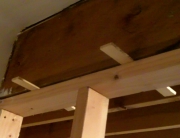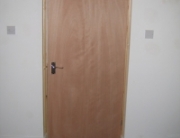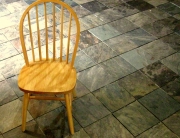How to Use a Pressure Washer. Step-by-step written instructions which accompany the video “How Set Up and Operate a Pressure Washer”
Tools & Supplies Needed
- Pressure Washer (Note: If you don’t own one, pressure washers can be rented by the day from most home improvement stores)
- Personal Protective Equipment
- Safety Glasses
- General Supplies
- Gas for the pressure washer (if using a gas-powered model)
- Household Bleach & Water Solution (1 part bleach to 6 parts water) OR
- Pressure Washer Cleaning Solution
- Access to running water
- Other – You will need a hard flat surface on which to place the pressure washer, and room to move around it
Steps to Operate Pressure Washer
1. Put on your safety classes.
2. Attach the water hose: Check the screen in the water hose port to be sure that it is secure. Screw the hose into the port by hand. You may need to tighten it with a wrench or vise grips to prevent it from leaking.
3. Attach the water gun: Pull back the “collar” of the water gun hose while attaching it to the port. Release the collar to secure it.
4. Important Note: Before turning on the pressure washer, you must turn on the water first!
5. Clearing the air out of the pressure washer: Before starting up the washer, let the air out by holding down the trigger of the water gun. You will hear it sputtering. When the sputtering stops and there is just a light stream of water coming out, you will know that you have let out the air sufficiently.
Important Tip: Pressure is building up inside the machine by the water that is flowing through it. So keep this rule in mind: Anytime the pressure washer is sitting idle during the pressure washing process, you must pull the trigger on the water gun every couple of minutes to relieve the pressure.
6. Starting up the pressure washer. (Different models of pressure washers may be labeled differently, so consult your users’ manual if necessary)
a. Set the top lever to “Choke”
b. Set the bottom lever to “Idle”
c. Pull the pull rope to start the washer (similar to how you would start a lawnmower)
d. Once the machine gets going, you must change the lever settings
e. Move the top lever to “Run”
f. Move the bottom lever to “Fast”
7. Pressure Washer Controls: You control the width and the intensity of the spray by turning the nozzle at the end of the water gun. As the spray gets narrower, the water becomes harder and more intense. As the spray gets wider, it is less hard.
Tip: To clean wood, such as a deck, you want to use a spray setting that is somewhat in the middle. There are very few jobs for which you would ever need the narrowest spray, and that setting can in fact damage wood easily.
8. Cleaning Wood: To clean wood such as a deck, a fence, or wooden furniture, prepare the surface first before washing it by applying a cleaning solution. Pressure wash the surface, using approximately a medium setting.
9. Cleaning Concrete: To clean surfaces such as driveways and cement patios, set the spray at a medium-high setting, and then wash. You will find that moss in particular comes off easily at this setting, and that you may not even need to use cleaner.
Due to differing conditions, tools, and individual skills, See Jane Drill assumes no responsibility for any mistakes, damages, injuries suffered, or losses incurred as a result of following the information published on our website and in the videos and written instructions published through our website. Before beginning any project, review the instructions carefully, and if you still have any doubts or questions about how to complete the project, consult with local experts or authorities. Also, because codes and regulations vary greatly by location, you should check to ensure that your project complies with all applicable local codes and regulations. Always read and follow all the safety precautions provided by any tool or equipment manufacturer, and follow all accepted safety procedures.
See Jane Drill is dedicated to providing accurate and helpful do-it-yourself information. We welcome your questions, input and feedback about the information provided on this website.
Copyright 2013, See Jane Drill, All Rights Reserved




Leave A Comment